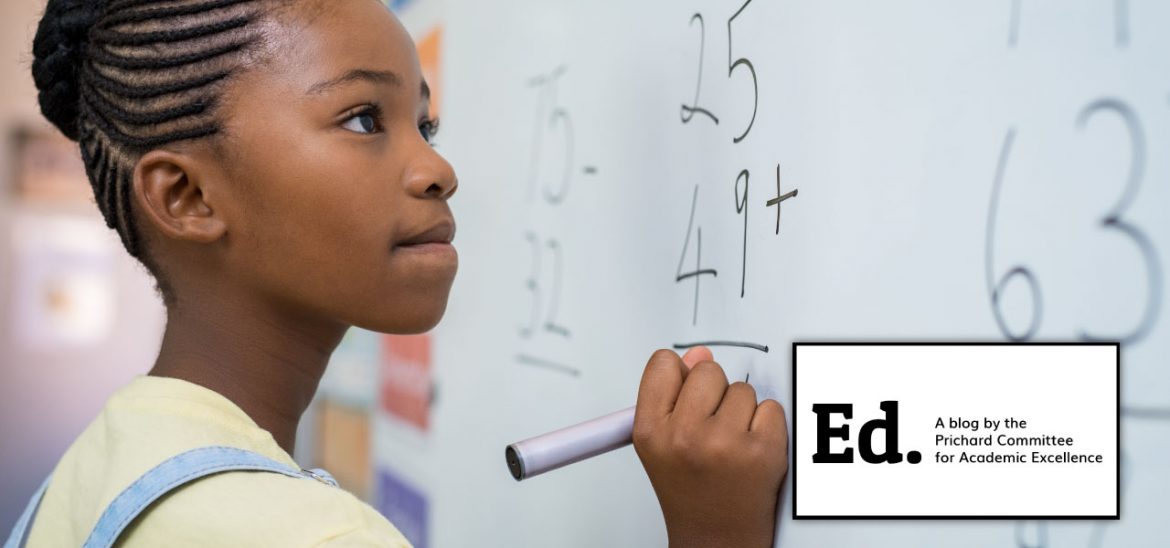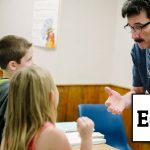By Brigitte Blom Ramsey
I recently returned from a meeting in Atlanta, Georgia where I had the pleasure of hearing about Mississippi’s incredible rise on the National Assessment of Education Progress (NAEP). No longer can the nation say, “thank goodness for Mississippi”; the state now meets the national average for students in 4th grade and 8th grade reading and math!
Mississippi’s rise is reminiscent of Kentucky’s own rise from the bottom of the national rankings during the 1990’s. Both, in the fact that Mississippi is outpacing the nation – and, that they are improving outcomes for all students – while stubborn academic achievement gaps persist between white and African-American students. The same has held true for Kentucky for decades.
Unfortunately, Kentucky’s rise in national rankings hit a plateau in about 2015 and we’ve begun to show signs of decline since then. The Prichard Committee has reported on this fact for the last couple years.
Kentucky must address our decline in education outcomes and we must address the disparities in educational outcomes for our African American students. We must do so with great urgency, courage, and commitment. Our state board of education, commissioner, legislators, and our communities, must be brave, steady, and focused on sustainable responses that embrace and support the needs of our African American learners and all their classmates.
First Step: Own our Truth
In reading and mathematics, we have not delivered progress for our African American students:
- Over the last 12 years, from 2007 to 2019, our results have been stagnant for African American 4th graders, holding flat at only 14 percent at or above the reading proficiency standard on NAEP.
- Similarly, we have failed to deliver for African American eighth graders in mathematics. In 2007 and in 2019, only 11 percent were at or above the NAEP math proficiency standard.
Meanwhile, schools nationwide delivered a step up for African American students on both assessments.
We can also see details in our statewide data about how our failures develop.
Elementary School – We allow our African American students to lose ground starting in kindergarten. In 2015, 45 percent of our entering African American students were reported fully ready for kindergarten, but by 2019, we had equipped only 30 percent of them to score proficient or above in KPREP reading.
Make no mistake, we moved white students and Hispanic students upward, so that more of them were reading proficiently than had been kindergarten ready. We moved children from low income homes upward, and students with identified disabilities, and students identified as English learners.
We let African American children fall. We let African American children fail.
High School – We can see our failure to deliver sharply in our data for the end of high school. In the last school year, we only moved 84 percent of our African American students to graduation in four years, and we only equipped 32 percent of those graduates for a successful transition to college or career. We served those learners less well than their white and Hispanic classmates and less well than their classmates who received free or reduced price meals.
We let African American children fall. We let African American children fail.
Higher Education – When we award degrees, we underserve African American scholars again. In 2018-19, only 6.8% of those receiving associate and bachelor degrees were African American (compared to 10.3% of our 2012-13 high school graduates and 11.3% of those who started ninth grade in 2008-09). We are not delivering the right mix of rigor and support to move African American young adults to credentials that equip them for a larger life.
We let African American children fall. We let African American children fail.
[This is not to discount the fact that we are seeing signs of improvement for African American students in higher education. Recent policies enacted by our state and universities are working and we must stay the course, continuing to improve postsecondary attainment for African American young people.]
Second Step: Identify Causes with Honesty
I have several starting ideas about how and why we are failing. The problems may include:
- Implicit bias – While teachers bear students no conscious ill will, they may bring unconscious beliefs into the classroom that lead to lower expectations, quicker frustration, and harsher perceptions. Research bears this out and we must all honestly inspect ourselves – with those adults working with our children every day, and leaders, having the most courage to ask important questions about their own unconscious beliefs.
- Lack of cultural competence – Appreciating and valuing the richness of difference in cultural background our students bring to school is critical in fulfilling the universal need of all of us to feel a sense of belonging and significance. Adults working with our learners must acknowledge their unique strengths in order to be successful fully engaging them in the learning process.
- Missed opportunities – Research shows that all students need access to rich, rigorous assignments, and the supports to meet the expectations of the assignment. Sometimes the supports come through relationships with their teacher or other educator, sometime supports come from helping the student see the relevance of the assignment – sometimes both, and sometimes additional supports are necessary. Isn’t that true for all of our children? This is where learning happens. This is true in the regular classroom, for Gifted and Talented, and advanced placement in high school. Opportunity is missed when there is limited access and limited support.
- Disproportionate Discipline – Something is wrong with our approach to discipline and it impacts the climate and culture of our learning environments for all students, while directly impacting our African American students. Last year, for every 100 African American students, we handed out 130 in-school removals. While that doesn’t mean that every African American student was removed, it does seem likely that every African American student saw someone like them removed from the classroom. In the same year, we removed just 51 white students for every 100, and just 33 Hispanic students for every 100.
We need courage to check out these possible explanations and to understand the impact. We need courage to look for other possible reasons we are not successfully delivering for African American learners.
Third Step: Identify and Implement Solutions
In our schools, we must find the courage to:
- Examine our own implicit biases, cultural competence, and depth of instruction – and accept honestly if we are coming up short.
- Work steadily to ensure a consistent culture of high expectations and deep, effective support for African American students.
- Come together, with time and conviction to implement strategies that will ensure rigorous, coherent learning for each of these learners. – that puts them on a path of growing success.
At the state level, we must find courage to:
- Strengthen our teacher recruitment and preparation efforts, including training to reduce the impact of bias, build cultural competence, and develop deeper learning approaches for the classroom.
- Revise our school report cards and accountability rules to meaningfully signal when one student group falls behind another in proficiency, enabling whole communities to see and work on those challenges together – responding to the unique needs of students locally.
- Give our youngest learners a strong start, making sure that high-quality childcare and preschool experiences are available to all low-income children.
- Make higher education affordable and provide effective student support services to ensure young adults persist and ultimately attain a high-quality degree or credential that is meaningful in the workforce and results in a family-sustaining wage.
A Big Bold Ask: $1 Billion for Education – to Support Equity & Excellence
Our steadfast commitment must include increased state investment – early childhood through postsecondary. The Prichard Committee is calling on state leaders to move forward with key investments across the education continuum, resulting in an increased $1 Billion between 2021-2026, including:
- Early childhood – Investing in childcare assistance and preschool, to allow high-quality early learning for 33,000 Kentucky children a year.
- K-12 – State Investment to fund full-day kindergarten and school transportation costs – freeing up local tax payer dollars to be used strategically by local districts to increase academic outcomes. And, a new Fund for Teaching Excellence to support increased teaching quality in priority areas like 3rd grade reading and mathematics – because teaching matters most!
- Higher Education – Fully funding the performance-based funding model which is proving to increase persistence and attainment of African American students as well as other student groups. And, increasing need-based financial support for Kentucky’s low-income learners, many of whom are first generation college students.
Community Conversations: An Imperative
In our communities, our courage must be strong enough to:
- Engage frankly with evidence about how we may be failing to build on the potential of African American students and other student groups.
- Work seriously to understand our biases, privileges, and structures of inequality and build our capacities to confront and change those patterns.
- Move effectively to support, respect, and demand whatever it will take to deliver full excellence with equity for African American students and all Kentucky learners.
All of these steps will strengthen education for all of Kentucky’s students. Improving how we deliver for Kentucky’s African-American children will improve outcomes for all children.
The reverse may not be true: when we speak of serving all children, our history says we can easily mask serious failure to deliver for African American students.
We must move forward into the next decade with the courage to see the talents and capacities of African American learners – respect them, treasure them, and deliver the environment, relationships, curriculum, and instruction that will develop and celebrate their fullest potential.
Courage is going to be required. Courage from all of us, and particular white Kentuckians. The first form of that courage is seeing that the problem is deep, enduring, and distinct.





Comments are closed.